
Bells and lamps of the temple
Lamps are lighted on all auspicious occasions. Deepavali is a celebration where lamps are kept in line and lighted. It is a practice in Sanatana Dharma that during morning and evening, a lamp is lit before the idol is present in the puja room of the house before household works are attended. It is a practice to light a lamp if any function is to be inaugurated. It is considered auspicious to begin the function with the lighting of the lamp. Therefore it could be seen that the lamps had played an important role on all occasions.
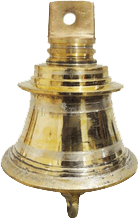 In the olden days, the temple was the centre for all activity of the village, and it acted as a nodal point for all social causes of the village. It was a belief that feeding the deity of the village was the duty of the villagers, after the offering of the food to the deity the bell of the temple would be rung and villagers used to take their food only after that. Every temple had a bell that could produce a sound that would reach the adjacent villages. This also indicates to the neighboring villagers that all is well in this village.
In the olden days, the temple was the centre for all activity of the village, and it acted as a nodal point for all social causes of the village. It was a belief that feeding the deity of the village was the duty of the villagers, after the offering of the food to the deity the bell of the temple would be rung and villagers used to take their food only after that. Every temple had a bell that could produce a sound that would reach the adjacent villages. This also indicates to the neighboring villagers that all is well in this village.
Apart from the bell which is a must in every village temple, lighting of two lamps in the temple is also considered a must. In the temple, a lamp is lit in the sanctum Santorum, and also in front of the temple to light the entire complex. As people normally gather in the temple, the common lamp lit in the temple used to provide light to the assembly of villagers.
Lamp of the deity inside the temple
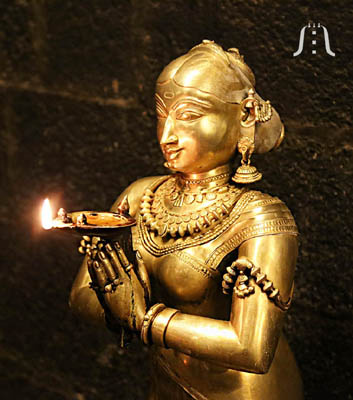 In the olden days temples especially in south India used to have the common lamp in the courtyard of the temple apart from the one which was lit for the deity inside the temple. Villagers used to donate oil for both. There are many inscriptions found in the temples that specifically state that land, cattle, etc being donated for the lighting of lamps in the temple.
In the olden days temples especially in south India used to have the common lamp in the courtyard of the temple apart from the one which was lit for the deity inside the temple. Villagers used to donate oil for both. There are many inscriptions found in the temples that specifically state that land, cattle, etc being donated for the lighting of lamps in the temple.
The main lamp will be for the deity at the ‘garbhagraham’. The lamp for the deity was a simple one to begin with, very elaborate artistic work was introduced in these lamps. Lamps which are of hanging type with five faces are very common. The famous lamp known as ‘pavai vilakku’ is designed as if a lady is in a standing posture and holding the lamp in her hand. The craftsmen of the south had marveled at themselves in designing numerous exclusive designs for this lamp which is placed near the vahanam of the deity just opposite ‘garbhagraham’.
A close look at the ‘garbhagraham’ and the deity, it can be observed that the moortham of Sri Anjaneya is carved as an embossment figure on a pillar. While Sri Anjaneya is facing east, conch [shanku] facing south, a tiruman mark facing west, and disc [chakram] facing north could be seen. These figures forms the bottom of the pillar and the pillar whose height is not known goes up to the top of the ‘garbhagraham’.
Common lamp of the temple
A common lamp just in the courtyard of the temple used to serve the entire community of the village. This used to be lighted along with the lighting of the lamp for the deity in ‘garbhagraham’.
In earlier days the courtyard of the temple was not laid with stone or cemented. Only it will be leveled and kept clean so that villagers can assemble. At the centre of the courtyard, a lamp is kept on a raised platform and lighted. Initially, it was made of earthen clay known as ‘Agal’ in Tamil Nadu. With knowledge of metals men started brass or bronze they started lamps using metals. Now instead of keeping on a raised platform, steam for the lamp cup was made. While on one end of the steam lamp will be fitted, the other side will be sharp thus making it easy to plant the lamp on the ground at different places. Since the lamp [vilakku] used to be shoved [kuttu] into the ground, the lamp was named ‘kuttu villakku’ in Tamil. The procedure remains the same in Malayalam it is called ‘nila vilakku’ here nilam means ground and villakku means lamp.
With the growth of population and the extravagance of the rulers, these metal kuttu villakku were replaced with stone pillars in the temples. Men started designing stone pillars for the temples. Every sculpture was beating the other in designing these lamp pillars for the temples. Thus pillars in the courtyard of the temple for lighting for the community became essential for the temple.
The practice of having a stone lamp pillar was prevalent in temples of South India. In Maharashtra the design was completely different, here the pillar will hold hundreds of lamps, in contrast to the practice of having one single lamp in South India.
Vijayanagar architecture
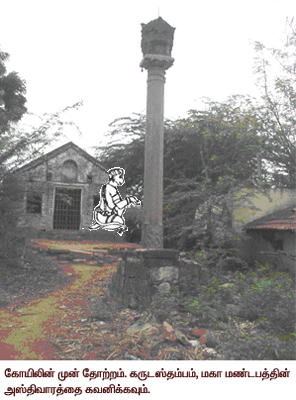 At one time most of South India was under the rule Vijayanagar Empire or its representative. Those glorious rulers had contributed to bringing back the lost value of Sanatana Dharma. As a part of this, they improved the existing temples and built new temples wherever required. Thus in many temples, the architecture was uniform which is popularly known as the ‘Vijayanagar style’.
At one time most of South India was under the rule Vijayanagar Empire or its representative. Those glorious rulers had contributed to bringing back the lost value of Sanatana Dharma. As a part of this, they improved the existing temples and built new temples wherever required. Thus in many temples, the architecture was uniform which is popularly known as the ‘Vijayanagar style’.
Stone lamp pillars
One such thing they had introduced is the Stone lamp pillars. These pillars are normally installed in line with garbhagraham - [in the front yard of the temple] vahanam, bali-peedam then Deepa stambam. In particular, the pillar round or hexagonal with a four-sided bottom is found before the balipeedam. It goes tapering to the top. The four sides of the pillar are embossed with Sri Garudar or namam [tiruman sign] on the side facing ‘garbhagraham’, the side facing outside [opposite] will have Sri Anjaneya and on the other two sides conch [sangu] and disc [chakram]. This arrangement is found in almost all the Lamp pillars of the Vaishnava temples.
Garuda Stamba
Lamp pillars are normally ten or twelve feet tall and found within the temple. In contrast to this, a huge and tall stamba is found in Vishnu temples just outside the temple which are known as Garuda stamba. The idol of Garuda is found on the top of this stamba. Garuda stamba which are found on the premises of Vishnu temples of north India dates back to 2nd BC in origin.
In south India as an extension of these lamp pillars in the temple, Garuda stamba was also built during the Vijayanagar period. Modeling on the same style, Vijaya stambas started coming up. One of the best Garuda pillars of Vijayanagar style is in Sri Rajagopalaswamy temple at Mannargudi Tamilnadu.
Prayers to deities in pillars
Devotees who are regular to their local temple whether big or small, had been offering prayers to the deities of their choice found in the pillars of the temple. Especially if the deity is Sri Anjaneya then one can see butter or vermilion having been applied to the deity. This can be seen in Kapaliswarar temple Mylapore, Meenakshi temple Madurai, Dharmarakshambikai temple Tiruvaiyaru, Anantha Padmanabhasway temple Trivandrum, and Guruvayur temple just to name a few. This is one form of expression of the devotee to show devotion to their loved deity.
The Village Talupulapalli
Talupulapalli is a simple village in Puthalapattu mandalam of Chittoor district. As one travels from Chittoor to Kadapa this village is on the 24th kilometer right on the National Highway No. 18 itself. The bus stop of the village is right in front of the simple village temple of Sri Hanuman.
The village economy is based on agriculture, but slowly few areas of this village are switching over to horticulture by growing mangoes and having a few mango orchards also.
Interestingly the name ‘Talupulapalli’ means ‘village without doors’. There must be a reason for this. Sri Anjaneya of this village will have to solve the riddle.
The temple of Sri Anjaneya
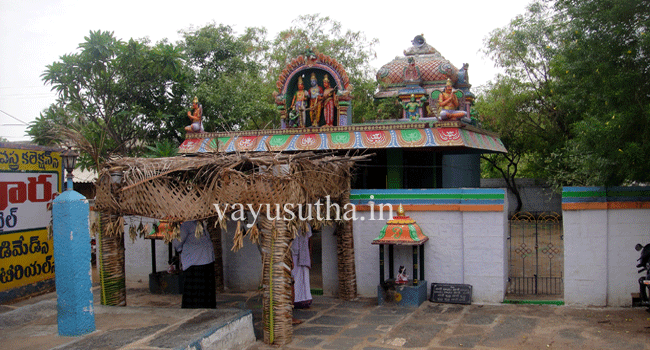 The temple of Sri Anjaneya of this village is facing east and is right adjacent to the highway. A big stone pillar of about ten feet is placed in the middle of a platform and on top of the pillar is a lamp making it a deepa stamba. In front of this is a four-pillared mandapam with a temporary roof. On both sides of the mandapam there are two small mandapams housing Sri Ganesa and Sri Maruga [Karthikeya]. Then a compound wall for the temple with an entrance in the middle is seen. As you enter the compound you can see a mandapam which has an ornamentally decorated arch at the top. The arch has Sri Rama Parivar depicted on it beautifully. In the center of the mandapam is the balipeedam. The vahanam [camel] of Sri Anjaneya is seen immediately behind the balipeedam. Next is the ‘garbhagraham’ in a raised position. From this point itself, one can have the darshan of the main deity. Devotees can make circumambulation of the main ‘garbhagraham’ from this point and the path is well laid. While going around one can see the imposing vimanam over the ‘garbhagraham’. On the four sides, one can see Sri Anjaneya in Sanjevaraya, Veera, Bhaktha, and Yoga forms in stucco figures.
The temple of Sri Anjaneya of this village is facing east and is right adjacent to the highway. A big stone pillar of about ten feet is placed in the middle of a platform and on top of the pillar is a lamp making it a deepa stamba. In front of this is a four-pillared mandapam with a temporary roof. On both sides of the mandapam there are two small mandapams housing Sri Ganesa and Sri Maruga [Karthikeya]. Then a compound wall for the temple with an entrance in the middle is seen. As you enter the compound you can see a mandapam which has an ornamentally decorated arch at the top. The arch has Sri Rama Parivar depicted on it beautifully. In the center of the mandapam is the balipeedam. The vahanam [camel] of Sri Anjaneya is seen immediately behind the balipeedam. Next is the ‘garbhagraham’ in a raised position. From this point itself, one can have the darshan of the main deity. Devotees can make circumambulation of the main ‘garbhagraham’ from this point and the path is well laid. While going around one can see the imposing vimanam over the ‘garbhagraham’. On the four sides, one can see Sri Anjaneya in Sanjevaraya, Veera, Bhaktha, and Yoga forms in stucco figures.
Pillar itself becomes temple
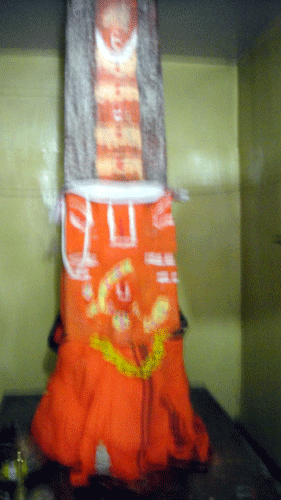 A close look at the ‘garbhagraham’ and the deity, it can be observed that the moortham of Sri Anjaneya is carved as an embossment figure on a pillar. While Sri Anjaneya is facing east, conch [shanku] facing south, a tiruman mark facing west, and disc [chakram] facing north could be seen. These figures forms the bottom of the pillar and the pillar whose height is not known goes up to the top of the ‘garbhagraham’. The vimanam is constructed covering the top portion of the pillar.
A close look at the ‘garbhagraham’ and the deity, it can be observed that the moortham of Sri Anjaneya is carved as an embossment figure on a pillar. While Sri Anjaneya is facing east, conch [shanku] facing south, a tiruman mark facing west, and disc [chakram] facing north could be seen. These figures forms the bottom of the pillar and the pillar whose height is not known goes up to the top of the ‘garbhagraham’. The vimanam is constructed covering the top portion of the pillar.
We presume that the pillar in the ‘garbhagraham’ should be a ‘deepa stambam’ and the post we see outside the temple should be a ‘garuda stambam’ of a huge temple of Sri Vishnu that should have been there in existence a long time ago. Now only the ‘garuda stambam’ and the ‘deepa stambam’ are found at this place where the ‘deepa stambam’ had been made as the main temple.
It is no wonder that this village had been named ‘Talupulapalli’. While Sri Anjaneya Himself is the rakshak of the village, why have a door? It is even more appropriate that Sri Anjaneya is found at the entrance to the village itself.
Sri Anjaneya
Lord Sri Anjaneya Swami moortham of this kshetra is about three feet tall and made of hard granite stone. Lord is in standing posture and the carving is of ‘ardha shila’ type. Lord’s left lotus foot adoring Nupuram and thandai is in the front. His right lotus foot is seen slightly raised from the ground. Lord is wearing kaupeenam and holds a small knife in the hip. His left hand adorning keyuram in his upper arm and bracelet on his forearm is seen holding the stem of a sowgandika flower. The flower which is still to bloom is seen above His left shoulder. He is wearing three malas as ornaments, one of which has a pendant adorning His bosom. The ‘upaveedam’ is flowing from His left shoulder across His broad chest. With His raised other hand He showers blessings on His devotees. The tail of the Lord rises above His head, the end of which is adorned with a small bell. Lord is wearing ear studs that are touching His shoulders. The Lord’s head is adorning a neatly tied ‘skika’ which is not seen in the ‘ardha shila’. His eyes are shimmering with karunya on the devotee. With such dazzling straight-looking eyes Lord of the kshetra is bestowing all ‘mangalam’ to the devotee.
Location of the temple: "Sri Anjaneya Temple, Talupulapalli village, Puthalapattu mandal, Chittoor Dist., A. P."
Experience
The protector and rescuer of this kshetra shower His blessings with His straight-looking eyes. darshan of this yathurmuki Anjaneya who bestows all courage and victory is sure to bring prosperity in the life of the devotee.
SRI HANUMAN THINKS DIFFERENTLY, THINKS FAST
THINKS AHEAD AND ACTS FOR SURE
Ed [Ed [January 2019]
Sri Hanumath Jayanthi Special
Updates: [Jan 2025]
